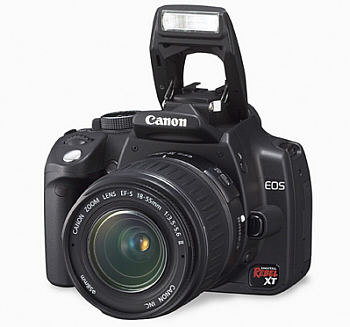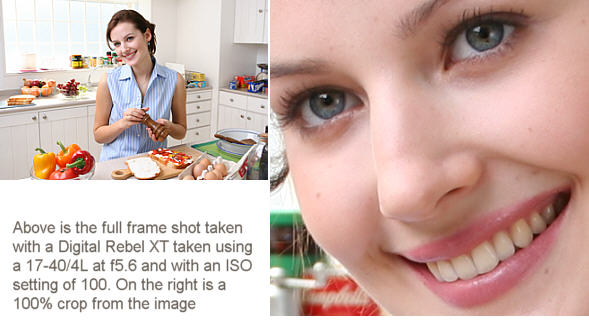
|
|
Canon EOS Digital Rebel XT (350D) vs. EOS 20D - A Comparison

Now the new Canon EOS Digital Rebel XT (the EOS 350D outside North America) has been announced, Canon buyers have a problem. Should they buy the EOS 20D or save $500 and buy the new Digital Rebel XT - or maybe even save another $200 and buy the original Digital Rebel?
All three are valid choices, but let's deal with the last one first. New XT or original? I think it's a no-brainer if you have the money. The new Digital Rebel XT has more pixels (8MP vs. 6.3MP), a lot more features and it will hold its value better. I think it's worth the extra $200 to go for the Digital Rebel XT. The original isn't bad and if you're on a very tight budget I think it's still a good camera, but the new Digital Rebel XT is better.
Now comes the more difficult question XT or 20D? I'm going to split this up into 5 sections:
For detailed information see the "Hands-on" review of the Digital Rebel XT
I'm pretty sure I won't list absolutely ever single similarity and difference, but I'll cover the major features. I'll revise the article as new information comes to light.
Things that are the same
- The sensor, though actually different, is very similar in physical size and pixel count
- Both have mirror lockup (enabled via a custom function)
- Both have flash exposure compensation
- Both have exposure compensation
- Both can set shutter speed and compensation in 1/2 or 1/3 stop increments
- Both have manually selectable evaluative, partial and center weighted metering modes
- Both have manually selectable one-shot, AI servo and AI focus autofocus modes (plus manual focus)
- Both have user selectable second curtain flash sync
- Both have the same white balance options
- Both have a monochrome (B&W) shooting mode
- Both have the same RAW and JPEG size and quality modes
- Both have the same 1.8" rear color LCD, with the same 5 brightness settings
- Both have the same selectable histogram display
- Both can print directly to compatible printers
- Both have a USB 2.0 interface
- Both are effectively "instant on". Startup time is 0.2s
- Both have the same white balance bracketing and correction
- Both have buffer which holds 6 RAW files
- Both use the .CR2 RAW file format
Things that are different, but not better or worse
- The EOS 20D uses BP-511/512 batteries, while the Digital Rebel XT uses the NB-2LH.
- The EOS 20D uses the RS-80N3 wired remote, the Digital Rebel uses the RS-60E3 wired remote.
Whether these are advantages or disadvantages depends on what other equipment you own and which
accessories and batteries they are compatible with. It's nice not to have to carry two different sets of batteries and chargers and two different remote releases.
- The Digital Rebel XT is smaller than the EOS 20D. Whether this is good or bad depends a bit on the size of your hands. Some may find the Digital Rebel too small, some may find the EOS 20D too big.
- The Digital Rebel XT is available in a silver finish. Some like it, some don't.
- The Digital Rebel LCD information display is on the back of the camera. The EOS 20D LCD information display is on the top of the camera.
- The layout of the menus for the two cameras is different. The layout on the EOS 20D is similar to that used on the EOS 10D and EOS 1D series cameras. They layout of the Digital Rebel XT is similar to the original Digital Rebel and the Powershot series of digicams.
Things that are different where the EOS 20D is better
- The EOS 20D has a rear QCD (Quick Control Dial) which can be used to set exposure compensation, flash compensation, shutter speed or aperture in manual mode and has several other functions. The same functions are available in the Digital Rebel XT, but require the pushing of buttons. The advantage of the QCD is you can do things faster and without taking your eye from the viewfinder.
- The EOS 20D can shoot at 5 frames/second, the Digital Rebel XT can shoot at 3 frames/sec
- The EOS 20D can shoot a burst of 23 high resolution JPEG frames before the buffer fills, The Digital Rebel XT can shoot 14 frames
- The EOS 20D has 9 autofocus zones, the Digital Rebel XT has 7
- The EOS 20D provides full cross-type performance with maximum apertures as small as f5.6, yet it achieves up to 3 times the standard focusing precision when used with EF lenses featuring maximum apertures larger than or equal to f/2.8.
The autofocus system of the Digital Rebel XT is inherited from the film Rebel XT body and has normal precision f5.6 sensors.
- The EOS 20D autofocus is specified to operate in 1 stop lower light than the Digital Rebel autofocus (-0.5 EV vs +0/5 EV)
- The EOS 20D autofocus is faster than the autofocus on the Digital Rebel XT
- The EOS 20D has a top shutter speed of 1/8000s, the Digital Rebel XT has a top shutter speed of 1/4000s
- The EOS 20D has a flash x-sync speed of 1/250s, the Digital Rebel x-sync speed is 1/200s
- The EOS 20D has a pentaprism with a 0.9x viewfinder magnification, the Digital Rebel XT has a pentamirror with 0.8x magnification.
- The EOS 20D has a highest ISO setting of 3200, the Digital Rebel XT has a high ISO setting of 1600.
- The EOS 20D is good for 1000 shots (no flash) on a single battery charge, the Digital Rebel XT is good for 600.
- The EOS 20D has a PC terminal for use with an external flash or strobe, the Digital Rebel XT does not.
- The EOS 20D maximum flash sync voltage is 250v (for both the hotshoe and PC terminal), the Digital Rebel XT maximum sync voltage is also 250v, not 6v as I had earlier reported. Canon have recently stated that the Digital Rebel XT does in fact share the 250v sync voltage with the 20D and other high end Canon EOS bodies. Sorry for any confusion on this point.
- The EOS 20D has a high performance shutter designed for increased reliability (100,000 cycles), the Digital Rebel XT has the normal Canon shutter (about 50,000 cycles).
- The shutter lag time of the EOS 20D is 65ms, the shutter lag time of the Digital Rebel XT is 100ms.
- The high-speed mirror drive give the EOS 20D a shortened viewfinder blackout time (115ms) compared to the Digital Rebel XT (170ms)
- The EOS 20D sensor (8.2MP, 22.5 x 15mm) is very slightly larger and has slightly more pixels than the Digital Rebel XT sensor (8.0MP, 22.2 x 14.8mm).
- The EOS 20D has a multi-controller on the back of the camera can be pushed in eight directions, as well as down in the center, to simplify selection of the AF point, correction of white balance, trimming of images during direct printing, scrolling of magnified images etc. The Digital Rebel XT uses push buttons for the same functions.
- The EOS 20D has top, front and rear covers made of a magnesium alloy for added strength and rigidity. The top, front and rear covers of the Rebel XT are plastic.
- The EOS 20D has 18 custom functions, the Digital Rebel XT has 9 (List of XT custom functions)
- The EOS 20D ships with Adobe PhotoShop Elements 2, the Digital Rebel XT ships with ArcSoft PhotoStudio 5.5. Adobe have an upgrade offer from Elements to full Photoshop CS for $299. This offer applies to copies of Elements which were supplied bundled with Canon products. Since Photoshop retails for up to $599 ($649 list), this can be a significant saving.
Things that are different where the Digital Rebel XT is better
- Price - a no-brainer. The Digital Rebel XT is around $500 cheaper!
- The Digital Rebel can use the low cost ($25) RC-1 and RC-5 infrared remotes. The EOS 20D can't.
- The Digital Rebel XT is lighter than the EOS 20D (17.1oz vs. 24.2oz)
Things we don't know
- When this articles was first written, the big unknown was image quality. Would the XT, with its slightly smaller - and
different - image sensor be capable of yielding image quality as good as the EOS 20D? Well, that question has been answered now
of course and the answer is yes. My own side-by-side tests showed that there's essentially no detectable difference in the quality of the images from the EOS 20D and the EOS Digital Rebel XT. Both are extremely high
There are some see some full size images shot with the Digital Rebel XT on the Canon (Japan) website (see sample below). They look very good with no indication of excessive noise. Sharpness, as you would expect, also seems excellent.

Bottom line - Which one?
Well, you've read the article, you have to decide for yourself. The Digital Rebel XT is designed more for the newcomer to digital SLRs and for users who don't need the added features and durability of the EOS 20D. The EOS 20D is designed more for the serious amateur and professional who work their cameras harder and expect them to do more. The difference is around $500 new and $500 is different for everyone. I'm sure it's pocket change for Bill Gates, but it may be a month's rent and food for a anyone with a limited budget. Only you can decide if you need any or all of the extra features that the EOS 20D offers, and if you can afford them. It's likely that the difference in image quality will be small, but that also applies to film cameras, where the image captured by a $200 film Rebel T2 is the same as the image captured by a $400 Elan 7N, an $800 EOS-3 or a $1600 EOS-1v, so clearly people don't buy cameras based only on image quality.
For myself, I'd choose the EOS 20D, but I'd have no hesitation in recommending the Digital Rebel XT to anyone who wanted to save $500. It looks like an excellent camera and probably provides the vast majority of users all the features that they will ever need. It is clearly a significant step up from the original Digital Rebel - which was itself a pretty good camera.
Links to other pages of interest
Where to Buy
My recommendation is AMAZON.COM. They're trustworthy, have good customer service and they are now shipping the EOS Digital Rebel XT. The first shipments went out on March 14th to those customers who ordered earliest. They offer free shipping
and a 30-day return policy. It usually takes a while after shipping starts before all backorders are filled and new cameras are available from stock, so if you want one soon,
placing a order now is probably a good idea. I'd go for the one in black with the kit lens, but that's just me!
| Silver Body |
Silver Kit |
Black Body |
Black Kit |
|
|
|
|
|
[Visit the HOME PAGE to see what else is new on the site]
© Copyright Bob Atkins All Rights Reserved
www.bobatkins.com
|
|
EOS 20D Body
EOS 20D Kit
|


